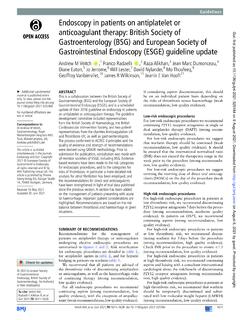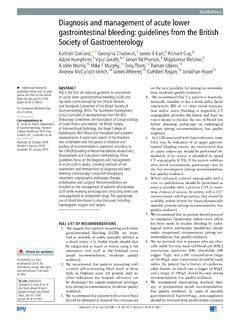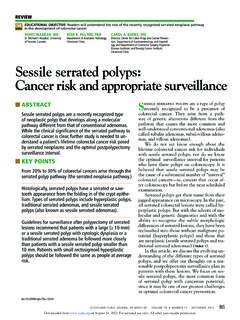Transcription of BSG Guidelines on the Management of Gastric Polyps
1 The Management of Gastric polypsAndrew F Goddard,1 Rawya Badreldin,2D Mark Pritchard,3 Marjorie M Walker,4 Bryan Warren,5on behalf of the British Society of GastroenterologyABSTRACTB ackgroundGastric Polyps are important as some havemalignant potential. If such Polyps are left untreated, Gastric cancer may result. The malignant potentialdepends on the histological type of the polyp. Theliterature base is relatively weak and anyrecommendations made must be viewed in light of Polyps are sessile or pedunculatedlesions that originate in the Gastric epithelium orsubmucosa and protrude into the stomach potentialDepending on histological type,some Gastric Polyps (adenomas and hyperplastic Polyps )have malignant potential and are precursors of earlygastric cancer.
2 They may also indicate an increased riskof intestinal or extra-intestinal OF RECOMMENDATIONS (QUALITY OFEVIDENCE, BENEFIT/HARM RATIO, STRENGTH OFRECOMMENDATION)<All types of Gastric polyp detected at endoscopyneed to be sampled for which forceps biopsyusually suffices (moderate, net benefit, qualified)<Biopsy of intervening non-polypoid gastricmucosa is recommended for all hyperplasticand adenomatous Polyps (moderate, uncertaintrade-offs, qualified)<IfHelicobacter pyloriis detected in patients withhyperplastic and adenomatous Polyps , it shouldbe eradicated (moderate, net benefit, qualified)<All Gastric Polyps with dysplastic foci andsymptomatic Polyps should be completelyremoved (moderate, net benefit, qualified)<All Gastric adenomatous Polyps should beremoved when safe to do so (high, net benefit,definitive)<If adenomatous Polyps are detected, an exami-nation of the whole stomach should be made formucosal abnormalities and any such abnorma-lities should be biopsied (moderate, net benefit,definitive)<Familial adenomatous polyposis should beconsidered as a diagnosis in young patientswith numerous fundic gland Polyps (low, uncer-tain trade offs, qualified)
3 <Endoscopists performing polypectomies must beproficient in performing endoscopic haemostasistechniques (low, net benefits, definitive)<Repeat gastroscopy should be performed at1 year for all Polyps with dysplasia that havenot been removed (moderate, net benefits, quali-fied)<Repeat gastroscopy should be performed at1 year following complete polypectomy forhigh risk Polyps (moderate, net benefits, qualified)ORIGIN AND PURPOSE OF THESE GUIDELINESThe widespread use of endoscopy has resulted inincreased detection of Gastric mucosal lesions,many of which are found incidentally. Gastricpolyps do not represent a uniform entity andencompass a wide variety of pathology that hasdiffering malignant potential and there arecurrently no Guidelines for the Management ofthese guideline aims to characterise Gastric polypsand provide a framework for , recommendations for diagnosis andtreatment of these Polyps remain controversial, asthere is no consensus.
4 Specifically, these guidelinesdo not cover the Management of early Guidelines are primarily intended for allendoscopists performing searchA search of Medline was made using key words: Gastric Polyps , adenomas, hyperplastic Polyps , fundicgland Polyps , inflammatoryfibroid Polyps , familialadenomatous polyposis, juvenile Polyps , juvenilepolyposis, PeutzeJeghers syndrome and Cowden of recommendationsThe quality of evidence for recommendations madein these Guidelines based on the GRADE recommendation is graded according to thequality of evidence, the relative benefit/harm offollowing the recommendation and the strength of evidence is graded as:highdfurtherresearch very unlikely to change our confidence inthe estimate of effect.
5 Moderatedfurther researchlikely to have an important effect on our confidenceon the estimate effect and may change the esti-mate;lowdfurther research very likely to have animportant impact on our confidence of the estimateof effect and is likely to change the estimate; orvery lowdestimate of effect is very is graded as:net benefitdtheintervention clearly does more good than harm;trade offsdthere are important trade offs betweenthe benefits and harm;uncertain trade offsdit isnot clear whether the intervention does more goodthan harm; orno net benefitsdthe interventionclearly does not do more good than of recommendation is recommended as:definitiveda judgement that most informedpeople would make.
6 Orqualifiedda judgementthat the majority of well informed clinicians wouldmake but a substantial minority would Diseases Centre,Royal Derby Hospital, Derby, UK2 Department ofGastroenterology, James PagetHospital, Great Yarmouth,Norfolk, UK3 Division of Gastroenterology,School of Clinical Sciences,University of Liverpool, UK4 Department of Histopathology,Faculty of Medicine, ImperialCollege, London, UK5 Department of Pathology, JohnRadcliffe Hospital, Oxford, UKCorrespondence toDr Andrew F Goddard, DigestiveDiseases Centre, Royal DerbyHospital, Uttoxeter Road, DerbyDE22 3NE, UK; 19 February 2010 Accepted 24 February 20101270 Gut2010;59:1270e1276.
7 Of guideline preparationThe literature review was performed by thefive authors of theguideline and draft Guidelines were prepared. The draft guidelinewas then reviewed by all members of the British Society ofGastroenterology (BSG) Gastroduodenal Section and PathologySection Committees. Two meetings were held involving allmembers of the Gastroduodenal Section Committee to redraftthe guideline. This redraft, once approved by the committee,was then reviewed by the BSG Clinical Services and StandardsCommittee. Further changes were made following recommen-dations from this committee and a consensus guideline consensus guideline was sent to all 279 members of theBSG gastroduodenal section.
8 Members were asked to assess eachrecommendation made and rate them as agree , neutral or disagree . This feedback was collated and a consensus meetingheld of ten representatives from the BSG gastroduodenal andpathology sections. The members of this consensus panel arelisted in appendix 1. Afinal version of the guideline was are usually asymptomatic and>90% are found inciden-tally. Larger Polyps can present with bleeding, anaemia,abdominal pain or Gastric outlet obstruction. Although sometypes of Polyps may have typical appearances at endoscopy thepresence of dysplasia cannot be determined without histologicalassessment. Therefore all types of Gastric polyp must be sampledto determine the pre-malignant risk.
9 Some Polyps are anexpression of a genetic disease and may also indicate anincreased risk of intestinal or extra-intestinal malignancy. Otherprecancerous conditions of the stomach include chronic atrophicgastritis and intestinal AND CLASSIFICATION OF POLYPSThe most common types of benign epithelial Gastric Polyps (BEGPs) are fundic gland Polyps , hyperplastic Polyps andadenomas. If there are multiple Gastric Polyps present, these areusually of the same histological WHO has classifiedgastric polyps34but this classification is controversial. Anupdated classification is suggested in box gland polypsFundic gland Polyps (also called Elster s glandular cysts) occur intwo distinct clinicopathological settings: as sporadic Polyps andpolyps associated with the syndrome, familial adenomatouspolyposis fundic gland polypsFundic gland Polyps (FGPs) constitute 16e51% of BEGPs5e7andmay be observed in of areusually multiple transparent sessile Polyps , 1e5 mm in diam-eter, located in the body and fundus.
10 Microscopy shows cysti-cally dilated glands lined by Gastric body type singlestudy8of 56 consecutive patients with FGPs suggested they canbe diagnosed with a high degree of accuracy based on endoscopicappearance FGPs are usually caused by activating mutations ofthe beta-catenin gene1112and usually number less than occurs in<1% of sporadic are notassociated with atrophic gastritis and the prevalence ofHelico-bacter pyloriinfection is very low in these have shown thatH pyloriinfection may have an inhib-itory effect on the development of FGPs but the cause of fundicgland Polyps remains uncertain, and these Polyps may regress oreven disappear in pump inhibitor-associated Gastric polypsSince 1993 there have been reports of the role of long-termproton pump inhibitors (PPIs) in the genesis of fundic one study FGPs were present in 23% of patientson PPIs compared with 12% of patients not taking a are usually small (<1 cm) and occur in the proximal/mid- Gastric reports have been retrospective studies andshow that the mean interval for polyp development months and that they regress within 3 months of PPIcessation.











